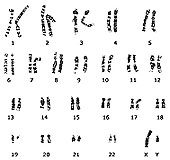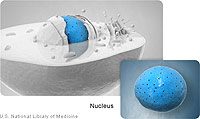On May 17, 2006, the journal Nature (the world’s leading scientific journal) published an important article: After 10 years of work, an international scientific team completed the decoding of the entire human genome. This is considered one of the most significant research projects of the century, as this success opens a new era in the fight against human diseases.
 |
|
The twenty-three human chromosomes. Chromosome 23 is named XY (determining sex) |
In a famous song, Trịnh Công Sơn compared our bodies to “dust,” and ultimately, we return to dust: What dust will transform my body / So that one day I return to become dust. It is possible that when writing this lyric, the musician was influenced by Buddhist philosophy, as he likely did not yet know about molecular biology, a field that began developing only in the 1980s. However, in general, those immortal lyrics accurately reflect the most basic unit of human beings. This unit of “dust” can be likened to genes, or more precisely, DNA (which we commonly refer to in French as ADN).
What are Genes?
Today, through advances in molecular biology, it is well understood that the most basic biological unit in a human being is the cell. Our bodies are made up of approximately 60 trillion cells (some estimates suggest this number is as high as 100 trillion). Many cells have different functions; for example, brain cells preserve memory and knowledge, heart cells ensure our hearts beat rhythmically, and intestinal cells produce mucus, etc. These cells have a certain lifespan. For instance, male sperm cells live for only a few months, while female egg cells can last up to 50 years.
 |
| Each cell contains a nucleus in the center |
Despite their different functions and lifespans, all cells share a similar structure: each cell contains a nucleus located in the center (Figure 1). On average, each nucleus contains about 1 billion DNA molecules (short for deoxyribonucleic acid). DNA is actually composed of 4 letters (bases): A (adenine), C (cytosine), G (guanine), and T (thymine).
These letters form chromosomes (Figure 2). The human body has 23 chromosomes, numbered 1 to 23, arranged by size (Figure 3). For example, chromosome number 1 is the largest (containing the most genes or letters), followed by chromosome number 2 (which has fewer genes than chromosome number 1), down to chromosome 23, which has fewer genes than chromosome 22. Each chromosome has many genes. For instance, chromosome 1 has 3,141 genes, which is twice as many as the average chromosomes. Chromosome 23 is actually named XY and serves to determine human sex. Females have XX chromosomes, while males have XY chromosomes. Upon fertilization, the embryo receives one chromosome from the mother and one from the father (which can be either X or Y). The chromosome from the mother is always X, while the chromosome from the father can be either X or Y. Therefore, if the embryo receives X from the mother and X from the father, it is a girl; but if it receives a Y chromosome, the embryo is male.
Genes are essentially segments of DNA. A segment of DNA is a collection of three letters known as a trinucleotide (which can be roughly translated as a triplet), such as TAG GCC TCA. A gene is a collection of many such triplets. For example, Figure 4 illustrates a segment of a gene composed of triplets TGA CTG ACT.
One can metaphorically describe this using a book as an analogy: In the book, there are 23 chapters (chromosomes); each chapter contains many stories (genes); each story has many paragraphs (exons); each paragraph consists of many words (codons); and each word is composed of letters (bases).
Genes function to send chemical signals throughout the body. These signals contain comprehensive information and specific instructions for how the organs in our body should operate. Understanding the number of genes and the organization of genes within the human body is crucial for advancing new and important developments in biomedical science. However, not all genes have clear functions. In fact, about 47% of genes do not have any specific function (or we do not yet know their functions).
How Many Genes Does the Human Body Have?
Previously, before the completion of the genome decoding project, scientists estimated that the human body contained about 100,000 genes. By 2001, when the first decoding results were published, this number dropped to 30,000 to 40,000 genes. However, now, after the genome decoding project is complete, scientists estimate that the human body contains only about 20,000 to 25,000 genes. Thus, the number of genes in humans may even be lower than that of mice (about 30,000 genes)!
 |
| Genes are made up of DNA. Each chromosome contains many genes |
Surprisingly, the number of genes in our body is even less than the number of genes in… rice plants! In 2002, scientists also completed the genetic mapping of rice and found that the indica rice variety (also known as bulu in Indonesia) has about 32,000 to 56,000 genes.
Why do humans have fewer genes than rice plants? This question has become an intriguing topic of speculation among scientists. It is important to note that although there are some genes with similar DNA structures between humans and rice plants, there is no evidence showing that genes are exchanged between rice and humans. In other words, genetically modified foods or fruits may not alter the genetic structure of humans.
Gene Variants and Their Effects
Each of us has about 25,000 genes in our bodies. For example, you and I both carry genes such as VDR, COLIA1, apoE4, etc. However, the differences between you and me lie in gene variants, not in the genes themselves. Genes are essentially entities with names, or to put it in mathematical terms, they are variables. For instance, height, weight, age, sex, etc., are variables. Each variable has multiple values: my height is 175 cm, yours is 180 cm, and many others may be taller or shorter. But sex only has two “values,” or more accurately, two groups: male or female. Each gene has multiple variants, referred to as genotype (gene variant).
Each variant is composed of two alleles: one allele received from the father and one from the mother. For example, the VDR gene has two alleles T and G, resulting in three variants: TT, TG, and GG. You may carry the TT variant, while I have the TG variant. For any gene, the frequency of variants often varies among different ethnic groups. For instance, in Asians, about 5% carry the GG variant of the VDR gene, while this frequency is 15% among Caucasians. Our differences arise from gene variants, not from the genes themselves.
 |
| Structure of a part of a gene, consisting of many trinucleotides TGA CTG ACT, etc… |
In addition to determining the characteristics of the human body, genes can also cause diseases. When a gene mutates (i.e., a segment of DNA suddenly changes, such as from TGCCA to TCCCA), it can cause cell disorders, diseases, or even death. Such a small change can lead to lifelong suffering due to genes! The challenge for 21st-century medicine is to find out which genes affect diseases. It is hoped that through decoding the human genome, scientists will eventually identify these “culprit genes.”
Besides using genetic information to diagnose diseases, genes can also determine the effects of medications. Everyone knows that for any disease, medications are effective (i.e., have good results) for about 50% of patients, while the other 50% may not experience any effect or may even suffer adverse effects. Recent research evidence suggests that differences in drug effects among individuals may be caused by genes.
Therefore, one of the biggest challenges facing medicine in the future is identifying which genes influence the effects of which drugs. This also means that, even after the human genome has been decoded, humans will not be free from disease, and the dream of immortality will not become a reality.
|
Decoding Genes and Its Dark Side We can envision a future where every individual possesses a biological identification card (similar to today’s credit card) containing all their genetic and hereditary information. When visiting a clinic or hospital, a doctor simply needs to insert this identification card into a computer, which will report the patient’s risk for various diseases, recommend medications, dietary suggestions, and more. This information is indeed promising. However, what if insurance companies gain access to these biological details? They could potentially refuse to sell you insurance based on your genetic makeup. In fact, some insurance companies in the United States already require their clients to disclose whether they carry genes associated with diseases that could lead to early mortality. Thus, while genetic information helps us understand ourselves better, it can also lead to discrimination and stigmatization. In reality, the analysis of thousands of genes for each individual is no longer a daunting task. The remaining question is whether the public is ready to accept such a scenario. The project of decoding genes represents a remarkable success of biotechnology but simultaneously raises numerous questions and challenges for society and humanity. |


















































